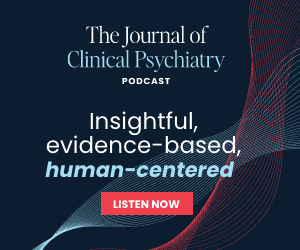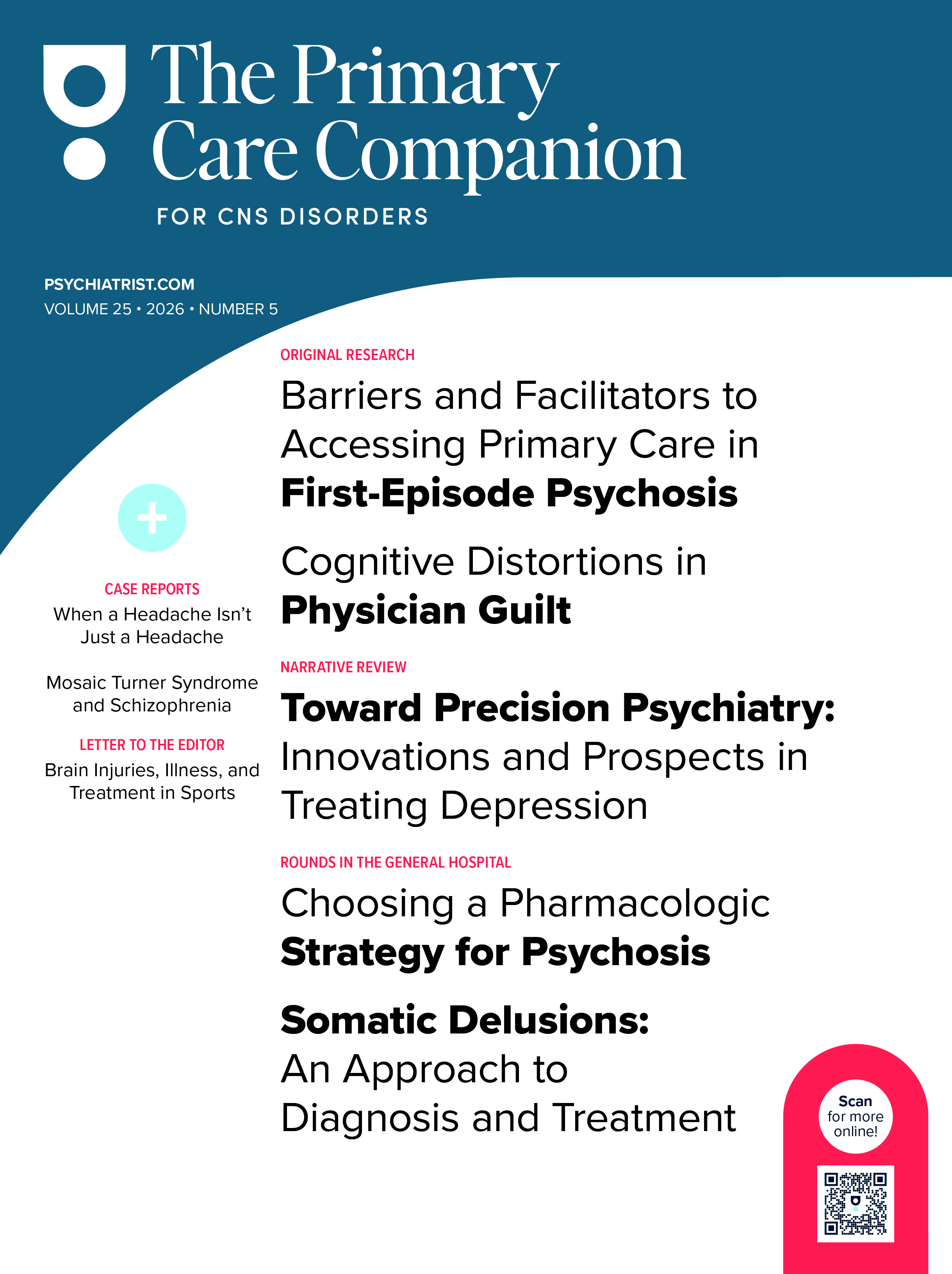Catatonia is a clinical syndrome characterized by mutism,catalepsy, staring, and echolalia.1 Excited catatonia subtype is typified by purposeless movements, agitation, stereotypy, combativeness, and repetitive speech.2 Catatonia is associated with antipsychotic medication use and benzodiazepine withdrawal; its association with opioid withdrawal is less well known.3 We present the case of a 37-year-old man who developed excited catatonia in the setting of concurrent opioid and benzodiazepine withdrawal requiring high dosages of benzodiazepines to resolve.
Case Report
The patient was a 37-year-old man with history of generalized anxiety disorder and chronic back pain managed on oral clonazepam 0.5 mg 4 times daily, oral methadone 5–10 mg every 4–6 hours as needed, and oral oxycodone 10–20 mg every 4–6 hours as needed with a maximum dose of 40 mg daily. He self-discontinued clonazepam 2 days before presentation and per family slept only a few hours with erratic behaviors, eg, mowing a neighbor’s lawn overnight. In the emergency department, he was disoriented and incoherent; cannabinoids, oxycodone, and methadone were noted on the toxicology screen. A complete blood count, complete metabolic panel, and thyroid panel were unremarkable.
The patient was admitted to the hospital for presumed benzodiazepine withdrawal and started on phenobarbital taper and 5 mg oral methadone twice daily. On hospital day 2, he displayed disorganized thought process, circumstantial and tangential speech, and echolalia. He later began to display pressured repetitive speech, verbigeration, and psychomotor restlessness. His temperature was 98.2 °F (36.8 °C), blood pressure was 175/86 mm Hg, and heart rate was 144 bpm. He had large fluctuations in heart rate and blood pressure, though remained normothermic throughout. The patient received lorazepam 2 mg intravenously for excited catatonia concern. The Bush-Francis Catatonia Rating Scale (BFCRS) was not performed, but improvement in symptoms within 30 minutes was documented.4 His outpatient prescription fill history was verified as 60 mg of methadone/day; accordingly, his hospital dose of methadone was increased to 10 mg every 4 hours, and home oral oxycodone was restarted at 10 mg 4 times daily. He was initiated on scheduled oral lorazepam 1 mg every 8 hours, and phenobarbital protocol was continued.
On hospital day 3, the patient displayed ongoing symptoms of catatonia with a BFCRS score of 22. As the patient lacked capacity to consent to electroconvulsive therapy (ECT) and family did not consent on his behalf, oral lorazepam dosage was escalated daily to a dose of 5 mg every 4 hours on hospital day 7 and continued until discharge on hospital day 15. On day of discharge, his BFCRS score was 0; he was prescribed lorazepam 5 mg every 4 hours to be taken until his outpatient psychiatry appointment.
Between discharge and scheduled psychiatry follow-up 2 weeks later, his outpatient methadone prescriber reduced the lorazepam dose from 5 mg every 4 hours to 4 mg every 4 hours for a daily total of 24 mg. His BFCRS score remained 0 at his outpatient psychiatry appointment, and his daily lorazepam dose was lowered from 24 mg to 22 mg total daily. Over the following 9 weeks, his lorazepam dose was decreased to 2 mg 3 times daily and then converted to clonazepam 1 mg 3 times daily due to reported side effects from the short-acting nature of lorazepam. At 16 weeks postdischarge, his BFCRS score was 0 on clonazepam 2 mg daily with plans for continued taper.
Discussion
Catatonia is diagnosed when at least 3 of 12 DSM-5 criteria are present.1 The BFCRS is a clinical screening tool for suspected catatonia. It consists of 14 categories, with a more rigorous 23-element scale used to determine severity if 2 or more are present.4
The patient initially met 5 of 14 BFCRS criteria. A lorazepam challenge was performed with symptom improvement within 30 minutes. Starting on hospital day 3, the 23-category scale was conducted at each evaluation to monitor improvement. Symptom resolution required an atypical benzodiazepine dose of 30 mg/day; catatonia typically responds to lorazepam doses of 6–21 mg daily.5 ECT is considered when symptoms persist beyond 1 week, or first line in cases of malignant catatonia. In our case, ECT was recommended but unable to be performed due to the patient’s inability to consent and family declining to consent on his behalf.
This case adds to literature found searching PubMed for “catatonia,” “opioid withdrawal,” and “benzodiazepine withdrawal.”3 Only 2 reports of isolated opioid withdrawal–related catatonia were found during this search.6,7 It is understood that benzodiazepine withdrawal reduces GABA-mediated inhibition, creating central nervous system hyperexcitability, while opioid withdrawal may further exacerbate this state through alterations in the endogenous opioid system. Naloxone reportedly improving catatonic symptoms, and opioid-related catatonic features like rigidity and akinesia, suggests a role for the opioid system in catatonia.8 The interplay between withdrawal syndromes may increase susceptibility to catatonic states, highlighting the need for heightened clinical awareness in such cases.3,7–9 The previous case reports involving opioids and benzodiazepines as precipitating factors involved malignant catatonia, which this patient did not develop as evidenced by the absence of fever and lack of leukocytosis or significantly elevated creatine kinase.3
Conclusion
This is the first published case, to our knowledge, that illustrates excited catatonia in the setting of concurrent opioid and benzodiazepine withdrawal that was successfully alleviated with high-dose lorazepam. This case adds to the other published reports of malignant catatonia in the same context.
Article Information
Published Online: June 5, 2025. https://doi.org/10.4088/PCC.25cr03927
© 2025 Physicians Postgraduate Press, Inc.
Prim Care Companion CNS Disord 2025;27(3):25cr03927
Submitted: January 27, 2025; accepted March 31, 2025.
To Cite: Levey JG, Meyer Karre VM, Balasanova AA. Excited catatonia in the setting of concurrent opioid and benzodiazepine withdrawal. Prim Care Companion CNS Disord 2025;27(3):25cr03927.
Author Affiliations: College of Medicine, University of Nebraska Medical Center, Omaha, Nebraska (Levey); Department of Psychiatry, University of Nebraska Medical Center, Omaha, Nebraska (Meyer Karre, Balasanova).
Corresponding Author: Alëna A. Balasanova, MD, Department of Psychiatry, Poynter Hall 5th Floor, University of Nebraska Medical Center, 985578 Nebraska Medical Center, Omaha, NE 68198-5578 ([email protected]).
Relevant Financial Relationships: None.
Funding/Support: None.
Patient Consent: Consent was received from the patient to publish the case report, and information has been de-identified to protect patient anonymity.
ORCID: Alëna A. Balasanova:
https://orcid.org/0000-0001-9735-2712
References (9)

- American Psychiatric Association. Diagnostic and Statistical Manual of Mental Disorders, Fifth Edition, Text Revision: DSM-5-TR. American Psychiatric Association Publishing; 2022.
- Burrow JP, Spurling BC, Marwaha R. Catatonia. In: StatPearls. StatPearls Publishing; 2024.
- Sayles BD, Royer EG, Meyer VM, et al. Malignant catatonia induced by concurrent opioid and benzodiazepine withdrawal. Prim Care Companion CNS Disord. 2023;25(2):22cr03346.
- Bush G, Fink M, Petrides G, et al. Catatonia. I. Rating scale and standardized examination. Acta Psychiatr Scand. 1996;93(2):129–136. CrossRef
- Fink M, Taylor MA. The catatonia syndrome: forgotten but not gone. Arch Gen Psychiatry. 2009;66(11):1173–1177.
- Lay S, Nguyen LL, Sangani A. Catatonia and opioid withdrawal: a case report. Cureus. 2024;16(3):e56396.
- Yeoh SY, Roberts E, Scott F, et al. Catatonic episodes related to substance use: a cross-sectional study using electronic healthcare records. J Dual Diagn. 2022;18(1):52–58. CrossRef
- Sandyk R. Endogenous opioid system in catatonia. Psychiatry Res. 1985;15(2):159. CrossRef
- Havemann U, Kuschinsky K. Neurochemical aspects of the opioid-induced “catatonia”. Neurochem Int. 1982;4(4):199–215. CrossRef
Please sign in or purchase this PDF for $40.





